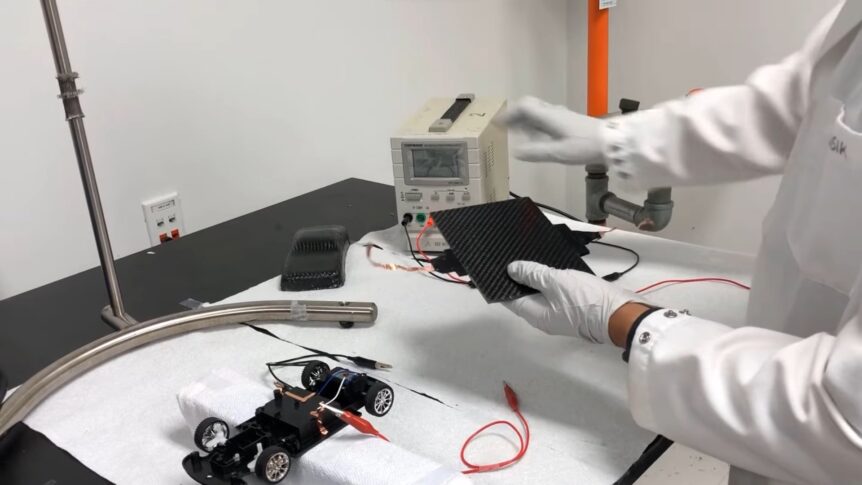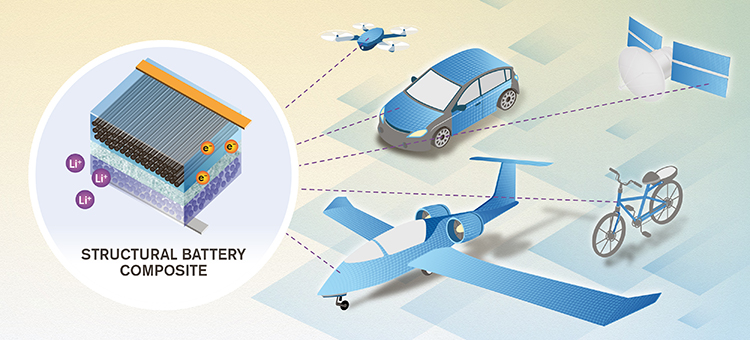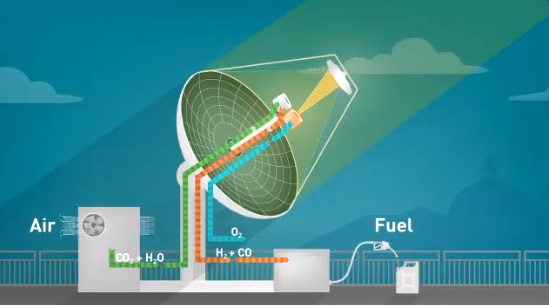Is it possible to combine the best features of batteries and supercapacitors to get both enduring energy storage and bursts of power? Batteries, to varying degrees can store energy and release it over time. Supercapacitors can provide instant, but short-lived power. Even more challenging, can can we form a hybrid structural battery, combining form with function? University of Central Florida researchers think they’ve answered those questions with a battery-supercapacitor hybrid material that could form “power suits” for electric vehicles. Improving on an Earlier Idea This blog first reported on structural batteries 12 years ago, examining the efforts of Volvo and Dr. Emile Greenhalgh of Imperial College London. Several approaches have been made to create a structural battery, but the “power suit” combines electrical potency with enough structural strength to resist driving impacts. UCF reports, “This new breakthrough continues this line of thinking, with scientists at University of Central Florida and NASA designing a new material featuring unique properties that allow for …
Massless Batteries for Aircraft?
What if the weight of the batteries in an electric airplane could virtually disappear? Researchers at Chalmers University of Technology in Gothenburg, Sweden have come up with an improved structural battery that exceeds the results of earlier research. So-called “massless batteries,” although not as energy dense as cylindrical or pouch lithium-ion batteries, could be worthy substitutes. The idea of making airplanes from materials that would provide energy from their inherent properties has been of interest for years. Your editor wrote an article on “The Grand Unified Airplane” for Kitplanes magazine in 2013 based on the idea of combining solar power, piezoelectric flexing of wings, and structural batteries. The ultimate goal was to create a machine that would move through the air on the energy of flight itself. This might seem an unreachable fantasy, but material scientists are bringing us closer to the dream. Headlining their report with a rather non-academic boast, Chalmers University promotes its, “Big breakthrough for ’massless’ energy …
APUS Introduces Two Zero Emission Craft
We’ve written several times about structural batteries in this blog, from Dr. Emile Greenhalgh’s early research at Imperial College to more recent efforts along the same line. Interestingly, the basic idea remains very much the same over a decade. Energy storage would take place in a monocoque-type structure that could use carbon fiber, fiberglass, and even graphene as a structural material, while acting as a battery. Now some of this thinking is being applied to hydrogen storage in wings. “TubeStruct™” APUS, an aircraft design, structure and certification operation in Strausberg, Germany, offering a full range of services including flight training. They recently announced two new craft, both featuring hydrogen fuel systems contained in a novel “… patented structurally integrated hydrogen storage system, known as TubeStruct™.” In the shadow drawings of the airplanes, the tubes appear as though they could double as redundant wing spars. The i-2, a four-seat Normal-Category (CS-23) aircraft; and “The APUS i-6 is a technology demonstration platform …
Recycling and Reusing Carbon in Jet Fuel
ETH Zurich (the Swiss Federal Institute of Technology), is recycling and reusing CO2 to make jet fuel as part of a carbon-neutral process. This is not a new idea, with others’ approaches to this detailed in earlier blog entries here, here, and here. Centered on a solar collector/reactor on the roof of ETH’s Machine Laboratory building in Zurich, researchers have “developed a novel technology that produces liquid hydrocarbon fuels exclusively from sunlight and air and have demonstrated the entire thermochemical process chain under real field conditions.” Extracting CO2 and water directly from ambient air through an adsorption/desorpton process, the system feeds these free materials into a solar reactor that is at the focus of the parabolic reflector that heats them to 1,500° Celsius. A cerium oxide structure in the reactor enables a redox (oxidation-reduction reaction)* cycle, with syngas an end product. This gas can be processed into a commercially-viable hydrocarbon fuel through conventional methanol or Fischer-Tropsch synthesis, according to GreenCarCongress. …
400 Watt-Hours per Kilogram by 2014
On its web site, the company boasts, “OXIS Energy is leading the World with its latest cell Energy Density and Capacity,” and proceeds to announce that it’s “developed its largest Lithium Sulfur cell achieving in excess of 300 [Watt-hours per kilogram]. This outperforms Lithium ion technology that has dominated the performance battery market for many years. In addition OXIS has achieved an increase in cell capacity to a 25 Amp-hour (Ah) cell – a world first.” They’re working toward a 33Ah cell. Claiming a twelve-fold improvement in the last 18 months, OXIS, a British battery manufacturer, says it has the confidence to “achieve a cell capacity of 33Ah by mid 2015.” The firm has hopes of energy densities “in excess of 400Wh/kg by the end of 2016 and in excess of 500Wh/kg by the end of 2018.” This doubling of energy density over the best of available lithium-ion batteries now would make the 175-mile-range Nissan Leaf a reality, and bring …
Graphene 3D Lab’s Graphene Filaments Work Magic
Graphene 3D Lab, Inc. has demonstrated that graphene can be easily mixed with thermoplastics commonly used in fused deposition modeling (FDM) 3D printers. The company has demonstrated a mixture of plastics and graphene that can be turned into nanocomposite material filament which can then be used within any standard FDM 3D printer. They have managed to craft a functioning battery which may be incorporated into a 3D printed object during printing. These filaments show good thermal and electrical conductivity and are shown in the video forming a 3D printed battery. Different components require separate “printings” at present, but company CEO Dr. Daniel Stolyarov explains that future iterations of the process will be able to simultaneously produce multiple material parts. His corporate biography lists significant accomplishments. “In his previous role at Energetiq, Dr. Stolyarov and his team won the 2011 Prism Award for the Laser-Driven Light Source they developed. He has also co-authored papers with Nobel and Kavli prize winners, as well …
Load-Bearing Supercapacitors
What if your battery served also as a wing or a fuselage? Several current efforts converge on creating batteries or supercapacitors that could function as structural elements in electric vehicles. We’ve reported on this before, with efforts by Dr. Emil Greenhalgh at Imperial College London and associated work by Volvo to make car components from the type of energy storing sandwich structure he developed. Your editor’s article on the “Grand Unified Airplane” in the July 2013 issue of Kitplanes magazine advanced the idea that such structures, coupled with graphene’s projected capabilities to collect solar energy, could lead to a self-powering aircraft. (In researching the current entry, he found that his idea had been done at model scale by BAE.) Reports from two universities show that others are working toward making that dream less than an idle fantasy. Researchers at Vanderbilt University are making headway toward creating a “Multifunctional Load-Bearing Solid-State Supercapacitor,” as titled in the American Chemical Society’s journal, Nano …
Conventional Batteries “A Thing of the Past?”
Volvo Car Group has announced their development of what they term, “A revolutionary concept for lightweight structural energy storage components that could improve the energy usage of future electrified vehicles.” Using carbon fiber and other composite materials to make batteries and supercapacitors within structural panels, Volvo hopes to offer “lighter energy storage that requires less space in the car, cost effective structure options and is eco-friendly.” This blog reported on earlier efforts by Dr. Emile Greenhalgh at Imperial College in London, working on creating energy storage with simple carbon-fiber/fiberglass/carbon-fiber sandwiches as an academic lead partner with Volvo. His work is directed toward creating structural supercapacitors, while efforts at Volvo in Sweden, led by Per-Ivar Sellergren and working with his nearly two-decade-old patents, are aimed toward crafting lightweight batteries to replace metal structures. Funded as part of a European Union research project, and concerned with improving energy storage, the effort has Volvo as its only car manufacturer. The car maker’s project …
Tripling Battery Range and Quelling Anxieties – Or Adding to Them?
Having recently been allowed a test drive in a Nissan Leaf , in which the late autumn leaves falling on the car made more noise than the car, I was taken by the quiet, the reasonable performance, and general sense of how much more refined everything is than on my well-worn 1995 internal-combustion vehicle. Cars are indeed getting better, but an issue remains with electric cars and airplanes – range. The Nissan representatives, a lively bunch of presenters who took prospective drivers through a “pre-flight” education program, admitted that shortcoming, and promised a coming series of charging stations dotting the I-5 from Canada to Mexico at 100-mile intervals, the demonstrated range for the Leaf. Israeli entrepreneur Shai Agassi has come up with an interesting twist on recharging, distributing battery switching stations around Israel. A customer pulls into the station and drives the nearly discharged vehicle over a pit, in which a robotized conveyor system and associated machines disconnect the drained battery and …
RGE Enters Ushuaia
Imperial College London’s Racing Green Endurance team has ended a 70-day adventure driving the length of the Pan-American Highway from Prudhoe Bay, Alaska to Ushuaia, capitol of Argentina’s Tierra del Fuego province, and southernmost city in the world. The 26,000 kilometer (16,120 mile) trip had moments of mechanical difficulties and some days of struggle. The electric supercar was stopped numerous times, sometimes for pushing speed limits, but often to satisfy police officers’ curiosity. Alexander Schey, M Eng in mechanical engineering and instigator of the trip, reports on his final hours on the journey with his co-driver, Toby Schulz, also an M Eng. “Finally I have a few moments to write the blog I have most been looking forward to write! 2 years of really hard work, 140 days of travelling and 70 days of driving have brought us to this moment, and I hope I can communicate to you just how incredible a feeling it is to have been able …
- Page 1 of 2
- 1
- 2




